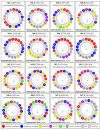In Silico Characterisation of the Late Embryogenesis Abundant (LEA) Protein Families and Their Role in Desiccation Tolerance in Ramonda serbica Panc
- PMID: 35408906
- PMCID: PMC8998581
- DOI: 10.3390/ijms23073547
In Silico Characterisation of the Late Embryogenesis Abundant (LEA) Protein Families and Their Role in Desiccation Tolerance in Ramonda serbica Panc
Abstract
Ramonda serbica Panc. is an ancient resurrection plant able to survive a long desiccation period and recover metabolic functions upon watering. The accumulation of protective late embryogenesis abundant proteins (LEAPs) is a desiccation tolerance hallmark. To propose their role in R. serbica desiccation tolerance, we structurally characterised LEAPs and evaluated LEA gene expression levels in hydrated and desiccated leaves. By integrating de novo transcriptomics and homologues LEAP domains, 318 R. serbica LEAPs were identified and classified according to their conserved motifs and phylogeny. The in silico analysis revealed that hydrophilic LEA4 proteins exhibited an exceptionally high tendency to form amphipathic α-helices. The most abundant, atypical LEA2 group contained more hydrophobic proteins predicted to fold into the defined globular domains. Within the desiccation-upregulated LEA genes, the majority encoded highly disordered DEH1, LEA1, LEA4.2, and LEA4.3 proteins, while the greatest portion of downregulated genes encoded LEA2.3 and LEA2.5 proteins. While dehydrins might chelate metals and bind DNA under water deficit, other intrinsically disordered LEAPs might participate in forming intracellular proteinaceous condensates or adopt amphipathic α-helical conformation, enabling them to stabilise desiccation-sensitive proteins and membranes. This comprehensive LEAPs structural characterisation is essential to understanding their function and regulation during desiccation aiming at crop drought tolerance improvement.
Keywords: 3D protein structure modelling; de novo transcriptome assembly; differentially expressed gene analysis; drought; intrinsically disordered proteins; liquid–liquid phase separation; resurrection plants; secondary structure prediction.
Conflict of interest statement
The authors declare no conflict of interest. The funders had no role in the design of the study; in the collection, analyses, or interpretation of the data; in the writing of the manuscript; or in the decision to publish the results.
Figures






Similar articles
-
Desiccation Tolerance in Ramonda serbica Panc.: An Integrative Transcriptomic, Proteomic, Metabolite and Photosynthetic Study.Plants (Basel). 2022 Apr 28;11(9):1199. doi: 10.3390/plants11091199. Plants (Basel). 2022. PMID: 35567200 Free PMC article.
-
Desiccation tolerance of the resurrection plant Ramonda serbica is associated with dehydration-dependent changes in levels of proteolytic activities.J Plant Physiol. 2014 Jul 15;171(12):998-1002. doi: 10.1016/j.jplph.2014.03.011. Epub 2014 Apr 16. J Plant Physiol. 2014. PMID: 24974326
-
Efficient protein extraction for shotgun proteomics from hydrated and desiccated leaves of resurrection Ramonda serbica plants.Anal Bioanal Chem. 2020 Dec;412(30):8299-8312. doi: 10.1007/s00216-020-02965-2. Epub 2020 Oct 10. Anal Bioanal Chem. 2020. PMID: 33037906
-
Desiccation tolerance in streptophyte algae and the algae to land plant transition: evolution of LEA and MIP protein families within the Viridiplantae.J Exp Bot. 2020 Jun 11;71(11):3270-3278. doi: 10.1093/jxb/eraa105. J Exp Bot. 2020. PMID: 32107542 Free PMC article. Review.
-
Resurrection plants of the genus Ramonda: prospective survival strategies - unlock further capacity of adaptation, or embark on the path of evolution?Front Plant Sci. 2014 Jan 10;4:550. doi: 10.3389/fpls.2013.00550. eCollection 2014 Jan 10. Front Plant Sci. 2014. PMID: 24454318 Free PMC article. Review.
Cited by
-
Drought-triggered leaf transcriptional responses disclose key molecular pathways underlying leaf water use efficiency in sugarcane (Saccharum spp.).Front Plant Sci. 2023 May 8;14:1182461. doi: 10.3389/fpls.2023.1182461. eCollection 2023. Front Plant Sci. 2023. PMID: 37223790 Free PMC article.
-
Enzyme stabilization and thermotolerance function of the intrinsically disordered LEA2 proteins from date palm.Sci Rep. 2023 Jul 23;13(1):11878. doi: 10.1038/s41598-023-38426-w. Sci Rep. 2023. PMID: 37482543 Free PMC article.
-
Identification and expression analysis of LEA gene family members in pepper (Capsicum annuum L.).FEBS Open Bio. 2023 Dec;13(12):2246-2262. doi: 10.1002/2211-5463.13718. Epub 2023 Nov 2. FEBS Open Bio. 2023. PMID: 37907961 Free PMC article.
-
Overexpression of AtruLEA1 from Acer truncatum Bunge Enhanced Arabidopsis Drought and Salt Tolerance by Improving ROS-Scavenging Capability.Plants (Basel). 2025 Jan 3;14(1):117. doi: 10.3390/plants14010117. Plants (Basel). 2025. PMID: 39795377 Free PMC article.
-
Acquisition of Freezing Tolerance of Resurrection Species from Gesneriaceae, a Comparative Study.Plants (Basel). 2023 May 5;12(9):1893. doi: 10.3390/plants12091893. Plants (Basel). 2023. PMID: 37176950 Free PMC article.
References
MeSH terms
Substances
Grants and funding
- grant no. 6039663/Science Fund of the Republic of Serbia
- No. 451-03-68/2022-14/200042, 2022/Ministry of Education, Science and Technological Development, the Republic of Serbia
- 451-03-9/2021-14/200053, 2021/Ministry of Education, Science and Technological Development, the Republic of Serbia
- 451-03-01963/2017-09/09/Ministry of Education, Science and Technological Development, the Republic of Serbia
LinkOut - more resources
Full Text Sources

